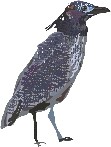 |
| Neikou Village |
We took Bus 287 to get to Neikou Village. After arriving
at Kangle Street, we finally reached the terminal station. On the trail
behind the bus station, a notice states that there are four ethnic
groups of birds in Neikou Village, that is crested serpent eagle,
kingfisher, Formosan blue magpie, and little egret. We looked at the
stream from the bridge and saw the kingfisher. The kingfisher was very
small, but the color was very beautiful. The difference between male
and female birds lies in the beak, male birds are all black, and female
birds are red. There were Spotted-necked dove on the iron house,
black-collared starlings, and crested mynas flying on both sides of the
bridge to stop. Walk by the bus station to the right of the small
bridge, and the entire stretch of mountain forest extends on the left
to the end. We looked to the side of the mountain and the leader told
us there were crested serpent eagle staying on the tree, but we looked
for a long time until we spotted one. |
The team leader looked for the tawny-flanked prinia and
yellow-bellied prinia between the white bamboo paddy field and
silvergrass along the way. There were common moorhen in the paddy
fields and black drongos on the electric wires. We continued on walking
when suddenly everyone stopped. It turned out that a crested serpent
eagle stopped on an electric pole. Since it was not far away, we could
carefully observe its appearance. The hair of the crested serpent eagle
crown was blown by the wind, and it swelled up and looked really
interesting. Its wax film and lores are yellow, and the features were
obvious. The bird stood on the electric pole, without moving. Birders
said that generally, the hawk would stand at the commanding height to
observe the prey around him and ready to attack at any time, especially
the crested serpent eagle, which was a snake-based raptor. We spent a
lot of time on the crested serpent eagle, which was most amazing today. | |
|
|
|
| Filmed by Bird Conservator |
The stream in front of Shengshan Church is Neigou Creek.
We walked along the stream trails without disturbing the creatures
around. Fortunately, we saw little egrets and night herons fishing in
the stream. We went straight to the Neigou Creek Ecological Museum. The
museum displays the topography model of the Neigou River Basin,
ecological photos and seed fruits. We can watch videos on the second
floor. The area next to and behind the museum is also a good place for
bird watching, butterfly watching and dragonfly watching. We rested in
the front square of the museum, checked the bird species, took a group
photo, and at this time found the Formosan blue magpie, which was of
blue feathers, and the white-and-black long-tail flying over the sky,
and flying away before we could the turn on the camera. |
|
|
|
| Filmed by Bird Conservator |
Here were 31 bird species in this routine activity in
Neigou Creek, and there were about 50 birders participating in the
activity. The most amazing experience was, besides the crested serpent
eagle, crested goshawk, Honey buzzards, there were Accipiter virgatus
and Gray-faced buzzards. After we checked and counted the bird species
in the Neigouxi Ecology Museum, some birds left first, while others
continued to find birds and admired the weathered rock wall of Mingju
Mountain.
| |
|
 |
https://ebird.org/checklist/S60957620?fbclid=IwAR11jgOUD57o8__v2tydNoOlYXirycjWeq2RsCCFqvk3Dlo54ph5nk8wdJ4
https://youtu.be/34U42QnXUp8?fbclid=IwAR25ojR_ZG9Zwp8SGBAQsm8TYH71dmwAjbhX1dsKomAoA6KrLGhapF1fic0
|
|
 |


























